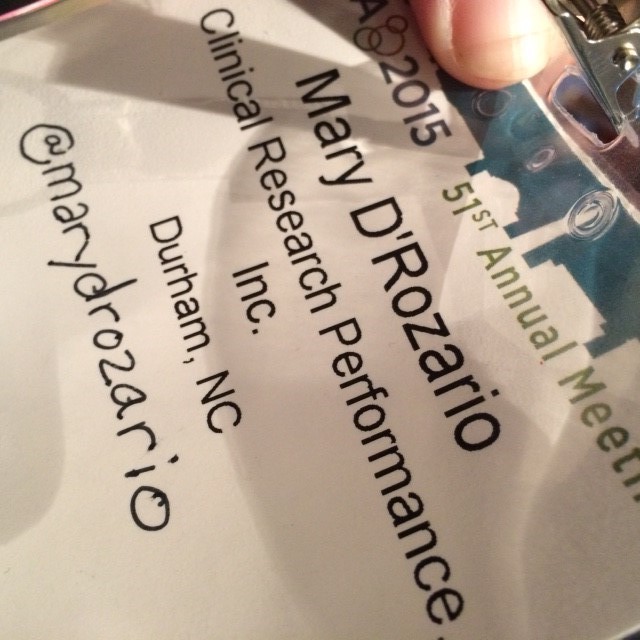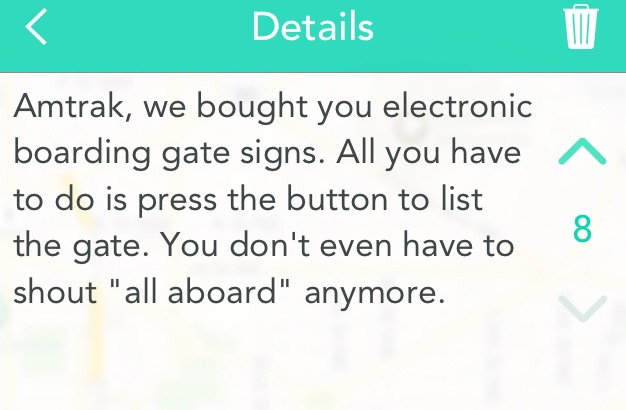DIA Annual Meeting Day 4: My Experience
marydrozario
I forgot to tell you this yesterday: I was on the escalator and turned around to eyeball the name tag of the woman behind me - never miss a networking opportunity! DIA doesn't print Twitter handles on name tags, so I had "fixed" mine.

"Mary D'Rozario! I know you. I follow you on Twitter."
Which is so incredibly generous, isn't it? And I didn't know her, at least I didn't think I did, so I had absolutely nothing generous to give back. "Thank you so much! I'm so sorry I didn't recognize you."
"Well 'I' don't follow you on Twitter," she clarified. "I tweet for my company and we follow you on Twitter."
So there you have it, Twitter marketing works even for an artless escalator networker such as myself.
Today was a half-day of sessions. First of all, I want to point out that Quintiles live-tweeted the FDA speaker in a session that I did not attend. This may not be the first time that Quintiles has live-tweeted someone that doesn't work for Quintiles, but it is the first time I have seen it. As the largest CRO in the world, this step forward into engagement is important for our industry. You can see some of what they are up to on the Storify they made on Day 3.
The first session I attended was on BYOD in clinical research with presentations from Chris Watson of Exco Intouch (they have some related content online), Paul O'Dononhoe of CRF Health and Stephen Joel Coons of the Critical Path Institute.
BYOD facilitation companies, it turns out, face the same problem that social media does: The concept that BYOD is "free." It of course is not free on the side of facilitating the use of the BYOD device, and there is also the cost of the device itself which is pushed off onto the patient. This caused some concern about the possibility of a future study where the inclusion criteria includes a list of devices, and what that means particularly for the poor. As the panel included xUSA speakers, I could only wonder what they thought of our clinical trials which sometimes exclude people without health insurance (not to mention the Right to Try legislation, previously discussed here, that can exclude people who cannot pay).
Benefits of BYOD are that the patient may be familiar with their device, is likely to keep it with them and keep it charged, and likely takes good care of the device that they own. Another issue is that people who have set up their devices to be adaptive for conditions such as blindness may have more opportunity to participate in clinical trials.
Negatives and difficulties make for a much longer list. One issue, discussed yesterday, is that we already have studies being evaluated by organizations like Patients Like Me from patient reported information before the studies even close. What happens when the patient has the actual study data in their position? And, if it is data that patient created on their device, and possibly on their own wearable device, who owns it? If it is exposed by the patient or by the patient's poor IT security behavior, who is liable for the exposure?
During the Q & A, a member of the audience pointed out that the FDA standard of "training and experience." How do we know a study coordinator is qualified to advise a patient on use of their BYOD device? How do we know a call center operator for the device or the app is qualified to at least know when they should not be discussing medical advice related to the device?
Another issue addressed during Q & A was the validation of survey instruments across devices. What was absolutely fascinating to me was that a member of the audience suggested a more nuanced view to how bias is controlled, the same kind of nuance that is needed in blinding. There may have been a breakthrough in the number of social media panels at this year's session, but the inescapable requirement to explain clinical research to the epatient is far bigger than just why and how to use social media. It is changing how clinical research professionals talk about clinical research in a fundamental way.
To go along with that change are new tools to implement new kinds of research. The subject of the next panel I attended was using provider EHR data and payer data (so-called Real World Information, RWI, or Real World Evidence, RWE) to solve problems in new ways.
Brett Jason Davis of ConvergeHealth by Deloitte (their RWE page) chaired the session. He pointed out that ACOs provide the incentive to collect Real World Information (RWI) and respond to it.
Bill Davis of Moffitt Cancer Center's M2Gen program presented on what they've been able to do with their opt-in database of all the health information (the EMR, 11 additional databases, and genetic information) of more than 130,000 oncology patients as well as de-identified information from all Moffitt patients since 1996. Three case examples: -Clinicians in another country thought they were seeing leukemia developing in subjects who had been on the original trial for a drug. They were able to query this database and determine that the incidence of leukemia was not related to whether people had used this drug. -Patients tended to be divided in response to a drug in that they either were found to be non-responders within the first three months, or they did will on the drug for years. Evaluating the database was able to identify the pathway that marked the different groups of patients. -Patients were pre-identify patients that would qualify for a particular clinical trial if their cancer progressed, providing 66% of all the subjects on the multi-center trial while also providing their patients with options they might have otherwise missed.
And lastly Brian Sweet from AstraZeneca's side of the Real World Evidence Health Collaboration (press release) presented three cases where data from a large provider was matched to data from a large payer and the analyzed for cost-saving solutions such as geographically targeted pre-natal interventions.
And then with my head full of the future I rushed to pack and got out of the hotel a few minutes late, then a few minutes delayed on the drive to Union Station, where I went running in desperate to find my train, and almost none of the trains on the electronic signage had their tracks lists. Once I found my train, a trek that included going the wrong way through a restricted zone that would have gotten me arrested an airport, I settled in and expressed my grudge on Yik Yak (a new social media channel that I wrote about the other day):

And then a beautiful ride home. The James River, near Richmond, Virginia:
Day 3 is posted here.
---
This blog post by CRP Social Media President Mary K.D. D’Rozario first published at http://www.crplink.com/blog.
